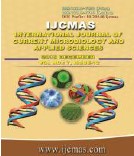


 National Academy of Agricultural Sciences (NAAS)
National Academy of Agricultural Sciences (NAAS)

|
PRINT ISSN : 2319-7692
Online ISSN : 2319-7706 Issues : 12 per year Publisher : Excellent Publishers Email : editorijcmas@gmail.com / submit@ijcmas.com Editor-in-chief: Dr.M.Prakash Index Copernicus ICV 2018: 95.39 NAAS RATING 2020: 5.38 |
A field experiment was conducted to study the mean incidence of major cotton insect pests during two consecutive seasons i.e. during kharif, 2010-11 and 2011-12 at CICR, Nagpur under high density planting system (HDPS) using different genotypes of G. hirsutum with different spacings. The main objectives of the work was to identify lines of G. hirsutum which have less infestation of major insect pests under HDPS system and to investigate whether the incidence is influenced by plant density. In 2010-11 the minimum mean population of leafhopper was on NISC-50 (1.82 nymphs/3 leaves/plant) with spacing of 45x13.5 cm followed by PKV-0811 (1.91 nymphs/3 leaves/plant) with spacing of 45x13.5 cm and these genotypes are significantly superior over the others. The injury grade was I on both NISC-50 and PKV-081. The mean per cent square damage was low in CNH-120 MB (2.76 %) followed by PKV-081 (3.82%) both were statistically on par with each other and significantly superior over other genotypes. The mean pink bollworm population was low on PKV-081 (2.53 larvae/25 green bolls). The lowest per cent locule damage due to pink boll worm was noticed on PKV-081 (8.48 %). However the performance of genotypes and geometry against the all insect pests in 2011-12 was not significantly different. Pest incidence was not altered by closer spacing.
 |
 |
 |
 |
 |